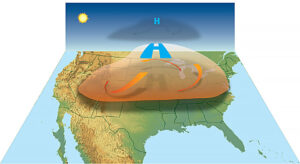Succinctly stated, pi, which is written as the Greek letter for p, or π, is the ratio of the circumference of any circle to the diameter of that circle. No matter the circle’s size, this ratio will always equal pi.
The value of pi in decimal form is approximately 3.14. However, pi is an irrational number, meaning that its decimal form neither ends (like 1/5= 0.20) nor becomes repetitive (like 1/3 = 0.133333…). Pi is 3.141592653589793238 to 18 decimal places.
Related: The history of “Pi Day”
While there is no precise value of pi, many mathematicians and math enthusiasts are interested in calculating pi to as many digits as possible. Rajveer Meena of India, who recited pi to 70,000 decimal places (while blindfolded) in 2015, holds the Guinness World Record for reciting the most digits of pi. Meanwhile, mathematicians using supercomputers have calculated the value of pi to more than 22 trillion digits.
According to Nathan Hamlin, a mathematician, and instructor at Washington State University,
“Pi is part of the nature of the circle. If the ratio was different, it wouldn’t be a circle.”
Pi was discovered by the ancient Babylonians. They calculated the area of a circle by taking 3 times the square of its radius, which gave a value of pi = 3. One Babylonian tablet, ca. 1900–1680 B.C., denotes a closer approximation, which is 3.125.
The Rhind Papyrus (ca.1650 B.C.), indicates that the Egyptians calculated the area of a circle using a formula that yielded the approximate value of 3.1605 for π.
The Greek mathematician Archimedes (287-212 B.C.E.) and the Chinese mathematician Zu Chongzhi (429-501 C.E.) are both given credit for calculating the most accurate approximations of pi before the existence of calculus and computers.
There is even a biblical verse where an apparent approximation of pi appears: “And he made a molten sea, ten cubits from the one brim to the other: it was round all about, and his height was five cubits: and a line of thirty cubits did compass it about.” — I Kings 7:23 (King James Version)
Archimedes approximated the area of a circle utilizing the Pythagorean Theorem to find the areas of two regular polygons: the polygon inscribed within the circle and the polygon within which the circle was circumscribed. The true area of the circle lies between the areas of the inscribed and circumscribed polygons, therefore, the areas of the polygons gave upper and lower boundaries for the area of the circle. This allowed Archimedes to approximate that π is between 3 1/7 and 3 10/71.
According to Peter Beckmann’s A History of Pi, the Greek letter π was first used by self-taught British mathematician William Jones in 1706, probably as an abbreviation of the periphery. The use of the symbol was later made popular by 18th-century Swiss mathematician Leonhard Euler, but wasn’t universally adopted until 1934.
Pi is widely used in science and mathematics. It is used to get values in trigonometry such as sine, cosine, and tangent. It is used to measure the circular velocity of things like truck wheels, motor shafts, engine parts, and gears, and it also measures the voltage across a coil and a capacitor. In fact, there is a filtering circuit in power supplies to block high frequencies which incorporates two capacitors going to ground connected by an inductor, thus forming the symbol for pi.
Pi has many everyday uses such as helping engineers figure out how to point an antenna toward a satellite under any circumstance, enabling a controller to drive a motor to move an actuator to control the flaps on an airplane, helping engineers calculate the size of giant cylinders used in refinery equipment and rolls of paper for printers, and determining the volume of hot water storage tanks.
Pi can be found not only in circles but in arcs, pendulums, and interplanetary navigation.
Pi has even found its way into the world of literature. Pilish is a dialect of English in which the numbers of letters in successive words follow the digits of pi. The following is an excerpt from Not A Wake, written by Mike Keit, which is the first book ever written entirely in Pilish:
“Now I fall, a tired suburbian in liquid under the trees, Drifting alongside forests simmering red in the twilight over Europe.” “Now” has 3 letters, “I” has 1 letter, “fall” has 4 letters, “a” has 1 letter, etc.
Pi has inspired a cult following that includes nerdy tattoos and its own national holiday which is celebrated on March 14.










